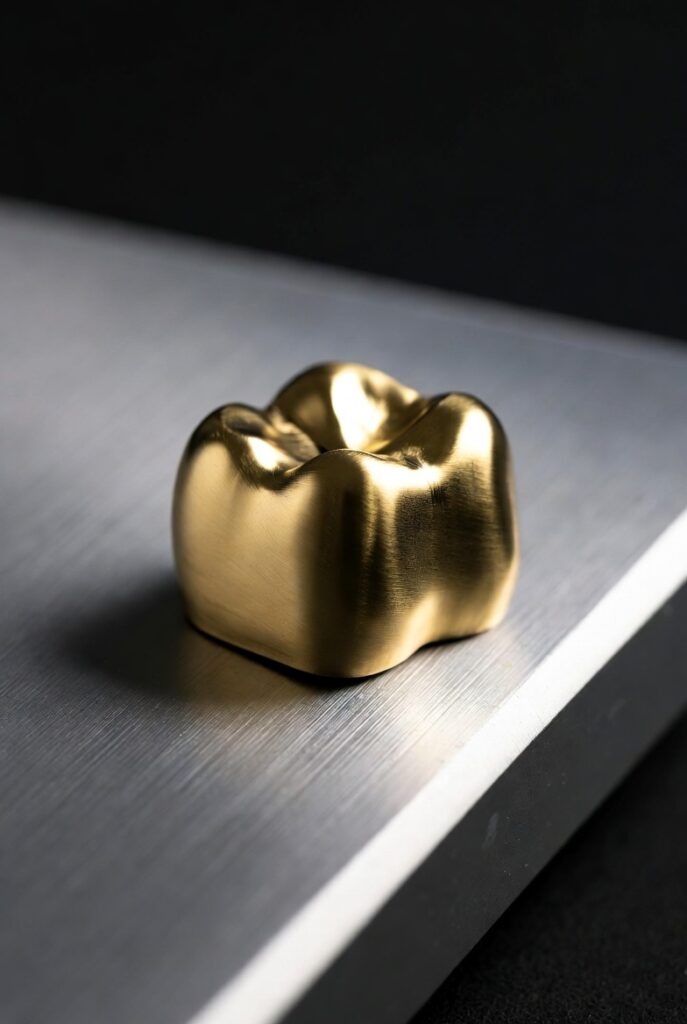
The Classic Standard of Strength and Longevity
While modern dentistry continues to evolve with cutting-edge ceramics and digital precision, one material has quietly stood the test of time, gold. Revered for its strength, reliability, and biocompatibility, gold crowns remain the benchmark for dental durability.
Gold crowns are especially favored for molars, the workhorses of the mouth where chewing forces are strongest and aesthetics take a back seat to function. In these areas, few materials perform as predictably or last as long as gold.
The Science Behind Gold Crowns
A gold crown is not made of pure gold but of a dental gold alloy, a carefully balanced combination of gold, platinum, palladium, and sometimes small amounts of silver, copper, or zinc. This alloy blend provides the ideal balance of strength, ductility and corrosion resistance.
Unlike brittle materials that can fracture under stress, gold alloys flex slightly under pressure. This elasticity allows them to absorb the intense chewing forces generated by the back teeth without cracking, a property unmatched by ceramics.
Key Advantage: Gold’s coefficient of thermal expansion is remarkably similar to natural tooth enamel. This means the crown expands and contracts at nearly the same rate as the underlying tooth, preserving the integrity of the cement seal and preventing microleakage, a major contributor to long-term failure in other materials.
Indications and Ideal Candidates
Gold crowns are the material of choice when longevity, precision, and function are top priorities.
Ideal Indications:
- Molars and premolars in non-visible areas.
- Patients with heavy bite forces or bruxism (tooth grinding).
- Teeth with minimal remaining structure where a thin yet strong restoration is needed.
- Cases where the opposing tooth needs gentle contact (gold is kind to opposing enamel).
Contraindications:
- Front teeth or visible areas where appearance is critical.
- Patients with aesthetic-driven expectations for tooth-colored restorations.
Engineering Precision: Why Dentists Still Trust Gold
Dentists often describe gold as the most predictable material for long-term success. It can be cast to micrometer precision, allowing for flawless margins and minimal gaps between the crown and the tooth.
The thinness of gold crowns also means less tooth reduction, preserving more of the patient’s natural structure compared to ceramic alternatives. Because of its malleability, the crown can be polished and adjusted to achieve a perfect bite without fracturing or weakening.
In the hands of a skilled dentist, a gold crown can fit so precisely that it becomes nearly hermetic, protecting the tooth underneath for decades.
🌍 The Historical Legacy of Gold in Dentistry
Gold’s use in dentistry dates back over 4,000 years. Ancient Egyptians, Etruscans, and Romans used gold wire and bands to stabilize loose teeth and replace missing ones — early precursors to the crowns we use today.
By the 19th and early 20th centuries, cast gold crowns became the pinnacle of restorative craftsmanship. Even as modern ceramics emerged, gold never lost its reputation as the “dentist’s material.” Its endurance in the profession speaks to a universal truth: no material combines strength, precision, and biocompatibility as elegantly as gold.
Advantages: Why Gold Still Reigns Supreme
- Unmatched Longevity: With proper care, gold crowns can last 30 years or longer, often outliving their patients.
- Gentle on Opposing Teeth: Gold’s smooth surface prevents wear on natural enamel.
- Precision Fit: Exceptional marginal seal reduces the risk of secondary decay.
- Minimal Tooth Removal: Gold’s strength allows for conservative preparation.
- Biocompatibility: Gold is inert, non-allergenic, and well-tolerated by gum tissue.
Limitations: Beauty Has Its Price
The only real drawback of gold crowns is aesthetic. While some patients appreciate the luxurious look of gold, others prefer a natural, tooth-colored appearance, particularly for visible areas. Cost can also be higher due to the precious metals involved, but this is offset by their unmatched longevity and performance.
Fun Fact!
During the California Gold Rush of the 1850s, dentists found themselves in high demand as prospectors sought gold crowns not only for function but as status symbols! Having a gold tooth was a sign of prosperity and resilience, a trend that continues in modern culture from hip-hop artists to high society.
Gold Crown FAQs
Q: How long do gold crowns really last?
A: Properly maintained, gold crowns can last for several decades, even a lifetime. They rarely fracture or wear down, making them the most durable material available.
Q: Do gold crowns cause any allergic reactions?
A: No. Dental gold alloys are highly biocompatible and do not corrode or react with the body’s tissues.
Q: Will a gold crown affect my bite?
A: Quite the opposite. Gold crowns are exceptionally smooth and easy to polish, allowing your dentist to fine-tune your bite to perfection.
Q: Are gold crowns still popular?
A: Absolutely — particularly among dentists themselves. Many professionals choose gold for their own posterior teeth because of its unmatched longevity and reliability.
